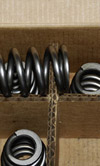There's plenty of R&D to Toyota Racing Development's valve springs
 As the newest player in NASCAR's Sprint Cup arena, Toyota Racing Development (TRD) in Costa Mesa, California is playing catch-up to manufacturers that have been in the sport for many, many years. According to David Currier, vice president of engine engineering for TRD, his company prefers to use multiple sources for its double-spring valve springs.
As the newest player in NASCAR's Sprint Cup arena, Toyota Racing Development (TRD) in Costa Mesa, California is playing catch-up to manufacturers that have been in the sport for many, many years. According to David Currier, vice president of engine engineering for TRD, his company prefers to use multiple sources for its double-spring valve springs.
"Our biggest challenge with valve springs is making them survive with more lift and extra cam work, trying to make them survive. We are constantly working on different designs and lots of testing to improve the valve spring," Currier told me. "It is basically a straight spring with flat tops; any taper would be unnoticeable to the human eye."
Because NASCAR rules determine valve spring material of simple steel spring wire, Currier can't work with exotic materials for his engine's needs. "We do a lot of FEA analysis and we drive development on our valve springs because we end up doing most of the testing and most of the analysis."
TRD drives development of its valve springs, but their suppliers have a lot of input into it. "For example a stiffer spring design might be more driven by them than by us: they'll say a reason for doing it and we'll say okay, we'll try it. Or it will be integrated into something we are doing, so it's kind of a mutual thing most of the time."
Although it's not always necessary, TRD does exchange its valve springs after every Cup race, which is a life cycle of about 700 miles on a standard race weekend. "We don't necessarily trickle those down even though they could last a bit longer," Currier said.
The configuration for an intake valve spring could be different from that of an exhaust and TRD makes changes "because the dynamics of the intakes versus the exhausts are a little bit different. The demands on each side are a little bit different; because of the interaction between them sometimes it's helpful to have them be a little bit different," he noted.
For TRD, specification updates on Cup valve springs is part of a whole package of things. "We run the changes about the same period for all of our internal parts and we might have three different valve spring options per year. We might use up some of our specs. For example, at some of the short tracks where top end power is not so critical, when we go to a new valve spring spec, we may use up some of the engines of the older spec at those particular races where it's not so critical or doesn't matter as much.
"Even though we're on and off the pedal a lot at that type of short track, it affects the wear of the spring somewhat, but when we qualify an open spec package, it's generally either for a particular track like a high-speed track (such as Atlanta or Fontana) and then it's only going to be for that. Or it's qualified for both the short tracks and fast tracks, which makes it less of a problem to switch over between one or the other."
The difference between Plate and Open springs is due to the duty cycle. At a Plate race, "It's such a constant speed; the RPM is lower and the throttle is always open, so the stresses are reduced and we can take advantage of that and do more with the spring," Currier said. "We can try and reduce friction or make it stressed more - put in more lift or a more aggressive cam - because it's not using that amount of stress capability, so we can lean on it a little harder. But then, when you lean on it harder, it usually fatigues and breaks and we end up with a milkshake," he laughed.
Fig. 1 - TRD prefers a double valve spring without insert (Photo courtesy of Toyota Racing Development)
Written by Anne Proffit